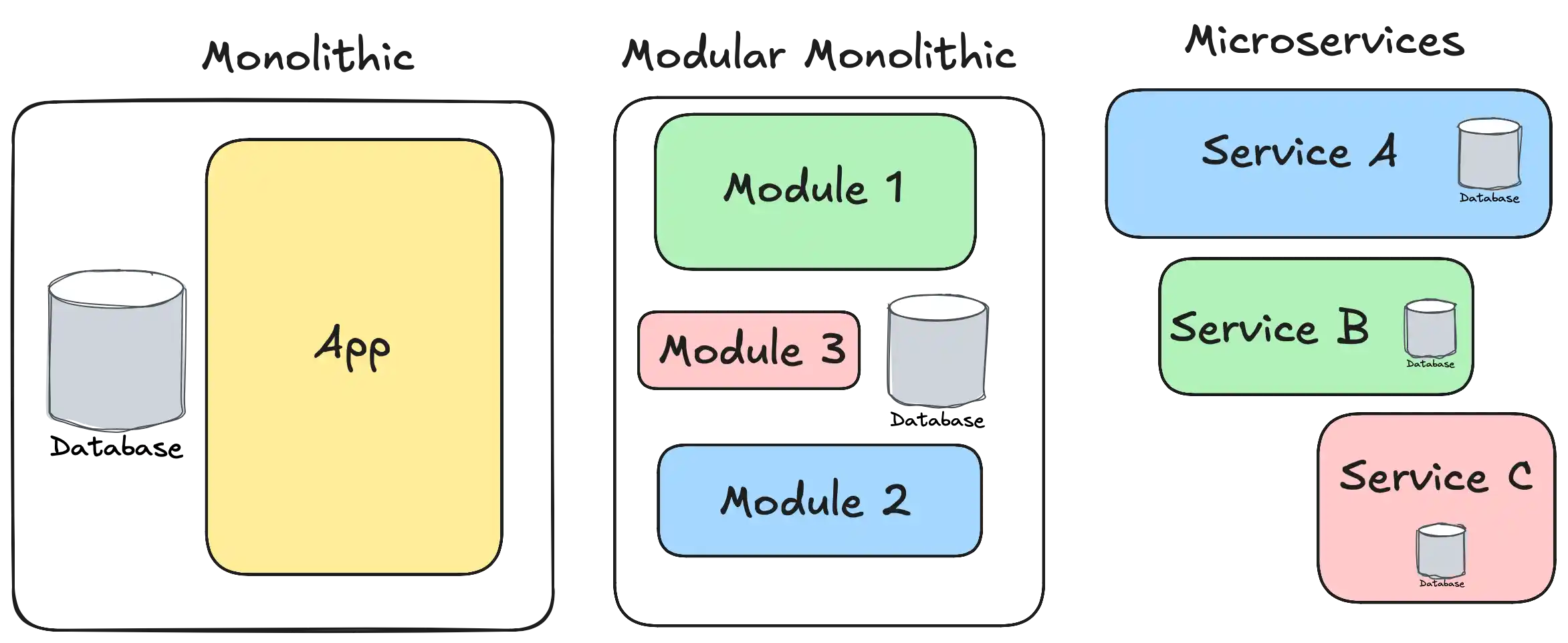
Miguel Aréjula Aísa
- 29/09/2025
Modular Monoliths vs Microservices: Choosing the Right Architecture in 2025
A practical guide comparing modular monoliths and microservices, helping developers choose the right architecture for their team, product, and scaling needs.
Every few years a new architectural trend captures the spotlight and for the past decade microservices have worn the crown. Big tech companies boast about their thousands of independent services and blog posts make it sound like the natural next step for any growing product. But for most teams, starting with microservices is like bringing a bulldozer to plant a small garden.
That’s where modular monoliths come in. Instead of slicing your system into dozens of deployable services from day one, a modular monolith keeps everything in a single codebase and deployment, while still enforcing strong internal boundaries. You get the clarity of separation without the operational overhead of managing a distributed system.
In this post, we’ll explore Modular Monoliths vs Microservices: what they really are, how they differ and when each approach makes sense in 2025. Whether you’re building a side project or scaling a fast-growing startup, understanding these trade-offs can save you from months of unnecessary complexity.
Definitions
Before diving into pros, cons and migration strategies, let’s make sure we’re speaking the same language. Terms like monolith and microservices get thrown around a lot and sometimes they mean different things to different teams.
Monolith Traditionally, a monolith is a single deployable application. All of your business logic, user interfaces and database access live inside one codebase, typically deployed as one unit. It’s straightforward, but can easily turn into the dreaded big ball of mud if internal boundaries aren’t respected.
Modular Monolith A modular monolith is still a single deployable app, but with strong internal boundaries between modules or domains. Each module encapsulates its own logic, communicates through well-defined interfaces and can be tested in isolation. Think of it as a monolith with guardrails: everything ships together, but each part knows its place.
Microservices Microservices take separation to the next level. Instead of one deployable unit, you have a network of independent services, each with its own runtime, database and deployment pipeline. Services communicate over the network, usually via HTTP or messaging, and can be built, scaled and deployed independently.

Key Dimensions of Comparison
Now that we’re clear on the terminology, let’s stack modular monoliths and microservices side by side. Here’s how they differ across the factors that most teams care about:
| Aspect | Modular Monolith | Microservices |
|---|---|---|
| Deployment | Single build and deployment pipeline. One artifact to ship and monitor. | Each service is deployed independently, requiring multiple pipelines, monitoring and coordination. |
| Team Structure | Works well with small to medium teams sharing the same repo and code conventions. | Supports large, autonomous teams who own their own services and release cycles. |
| Data Management | Usually one shared database (with schema boundaries per module). | Each service manages its own database, ensuring strong data ownership but complicating transactions. |
| Scaling | Scale the whole application together, even if only one module needs more resources. | Scale individual services independently, optimizing resources for hotspots. |
| Operational Complexity | Lower infrastructure overhead: fewer servers, simpler CI/CD, easier debugging. | Higher operational overhead: service discovery, load balancing, network latency, observability. |
| Technology Freedom | Typically one language/framework for consistency. | Each service can use different languages, frameworks or databases (but at the cost of complexity). |
When to Choose a Modular Monolith
For many teams, a modular monolith is the sweet spot, especially at the beginning of a project. Here’s when it shines:
-
Small to Medium Teams: If you’ve got fewer than ~20 developers, the coordination cost of microservices often outweighs the benefits. A single repo with well-defined modules keeps everyone moving fast without endless DevOps overhead.
-
Rapid Prototyping & Minimum Viable Products (MVPs): Early-stage products need to ship features and test ideas quickly. A modular monolith lets you iterate without worrying about inter-service communication, distributed transactions or complex deployments.
-
Evolving Domains: When you’re still figuring out your business logic, keeping everything together makes refactoring far easier. You can change module boundaries without breaking network contracts or orchestrating multi-service releases.
-
Limited Infrastructure or Ops Resources: If you don’t have a dedicated DevOps team, managing Kubernetes clusters, service meshes and CI/CD pipelines for dozens of services can become a nightmare. A single deployment is simpler to monitor, debug, and scale.
Imagine a small SaaS product; a B2B dashboard for analytics, with a 5–10 person team. You might have clear functional areas (auth, billing, reporting), but splitting them into independent services would only slow development and increase hosting costs. Instead, you can enforce module boundaries in code while still deploying a single, easy-to-manage application.
When Microservices Shine
While a modular monolith is often the best starting point, there comes a time when splitting into microservices makes sense. Here are the signs that it might be time to go distributed:
-
Clear and Stable Domain Boundaries: Your business logic is well understood and modules rarely need to change together. For example, a payment system and a recommendation engine operate almost completely independently.
-
Independent Scaling Needs: Some parts of your app handle much heavier loads than others. Maybe your real-time chat service is slammed while your admin dashboard barely breaks a sweat. Microservices let you scale hot spots individually instead of scaling the entire app.
-
Large, Autonomous Teams: Dozens (or hundreds) of developers working in parallel? Microservices allow teams to own services end-to-end code, database and deployments—reducing coordination headaches.
-
Technology Freedom: Different services can use the best tool for the job: a Python-based ML service, a Go-based API for speed or a Rust-based background worker. This flexibility is powerful, but requires strong engineering discipline.
-
High Availability and Fault Isolation: If one service goes down, the rest of the system can keep running. Properly designed microservices can limit blast radius and improve reliability.
Think of a global e-commerce platform handling search, payments, and inventory. Payments require strict compliance, search needs blazing-fast response times and inventory may need to scale independently during seasonal peaks. Microservices allow each of these areas to evolve, deploy, and scale on their own timeline.
Conclusion: Choosing the Right Architecture
Architectural decisions aren’t just about code—they’re about people, teams, and business needs. Both modular monoliths and microservices have their place, but picking the right one at the right time can save you months of frustration.
Modular Monoliths are ideal when:
- You have a small to medium team
- You’re iterating quickly on an MVP
- Your domain is still evolving
- You want simplicity in deployment and monitoring
Microservices shine when:
- You have large, autonomous teams
- Different parts of your system need independent scaling
- You need fault isolation and polyglot freedom
- Your domain boundaries are well understood
Start simple. Build a modular monolith with strong internal boundaries, good testing, and observability. Only evolve into microservices when your system, team, or business needs demand it. Optimizing for simplicity early keeps your options open—and avoids turning your codebase into a distributed nightmare.

